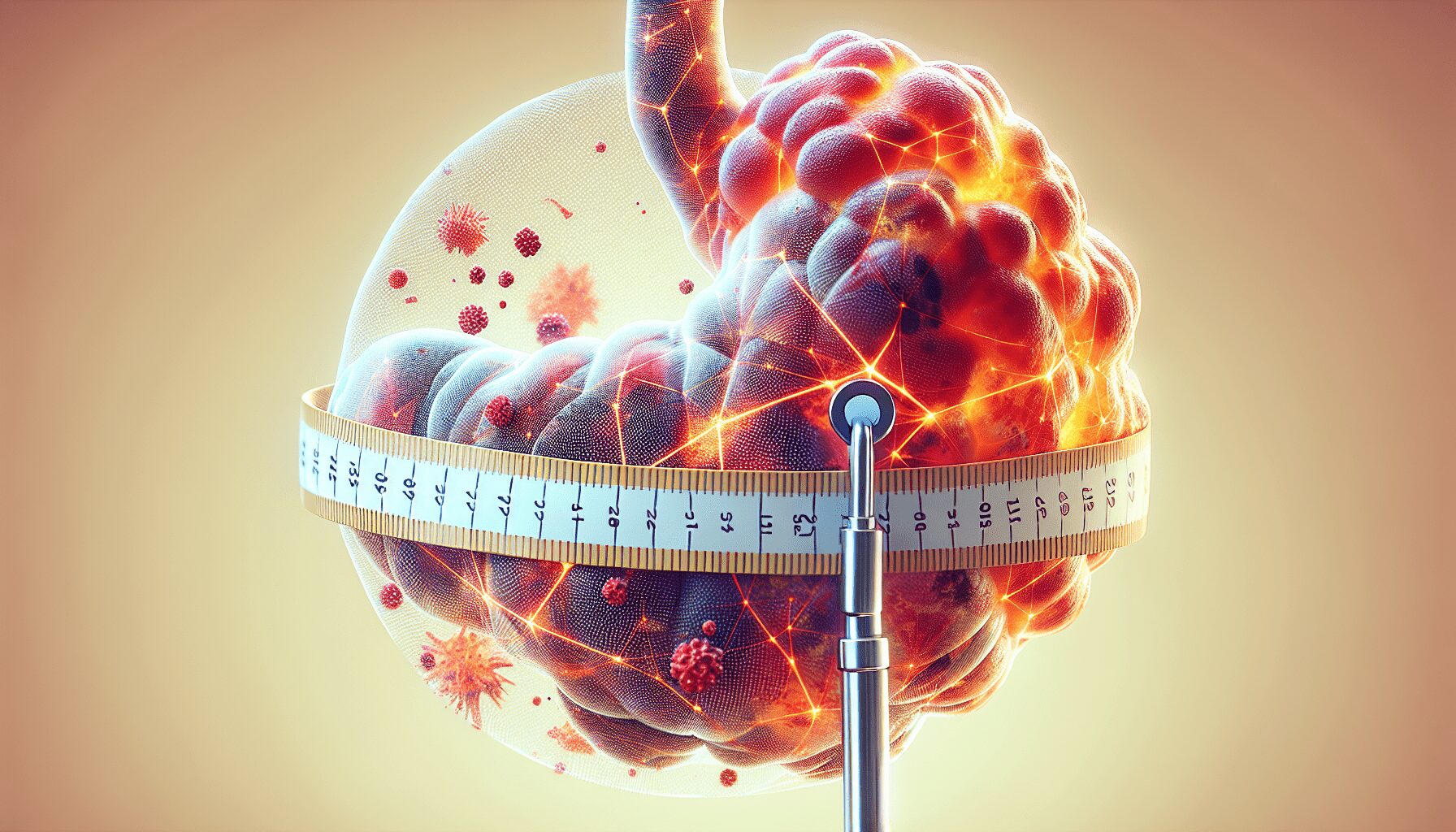Understanding the Difference: Bloating vs Fat

Are you tired of trying to figure out if that extra bulge around your waistline is bloating or fat?
In this article, we will help you understand the difference between bloating and fat, so you can finally gain clarity on what is actually happening to your body. Say goodbye to confusion and hello to a better understanding of your own physical health.
What is Bloating
Definition
Bloating refers to the feeling of fullness or tightness in the abdomen, accompanied by discomfort or distension. It is commonly characterized by an increase in the girth of the abdomen, making it appear swollen. It is important to note that bloating is not the same as weight gain or fat accumulation, although it can sometimes be mistaken for it.
Causes
Bloating can have various causes, including digestive issues, dietary factors, hormonal imbalances, and certain medical conditions.
Digestive causes of bloating include excessive gas production, impaired digestion, and slowed movement of food through the digestive tract. Dietary causes can range from consuming gas-producing foods, such as beans and carbonated drinks, to overeating or eating too quickly. Hormonal causes, such as fluctuations in estrogen and progesterone levels, can also contribute to bloating. Lastly, medical conditions like irritable bowel syndrome (IBS), lactose intolerance, and gastroesophageal reflux disease (GERD) can lead to bloating.
Symptoms
The symptoms of bloating can vary from person to person, but some common signs include abdominal discomfort, a feeling of fullness even after consuming small amounts of food, excessive gas, frequent burping or belching, a swollen abdomen, and changes in bowel movements. These symptoms may come and go, and they can be particularly bothersome after meals or throughout the day.
Strength Training and Core Exercises
Aerobic Exercises
Engaging in regular aerobic exercises is an effective way to burn calories and promote waist reduction. Activities such as brisk walking, jogging, cycling, and dancing can elevate your heart rate and help you shed those extra inches. Aim for at least 150 minutes of moderate-intensity aerobic exercise per week or 75 minutes of vigorous-intensity exercise for optimal results.
High-Intensity Interval Training (HIIT)
HIIT workouts involve short bursts of intense exercise followed by intervals of rest or lower intensity. This form of exercise not only improves cardiovascular fitness but also helps burn calories and fat, including the stubborn belly fat that contributes to waist circumference. Incorporate HIIT exercises like burpees, jump squats, and mountain climbers into your workout routine to accelerate waist reduction.
Swimming or Cycling
Swimming and cycling are low-impact exercises that can effectively target the waist area. These activities engage multiple muscle groups while providing a cardio workout. Whether you prefer a leisurely swim or a challenging bike ride, incorporating these activities into your routine can contribute to a smaller waistline and improved overall fitness.
Boxing or Kickboxing
Boxing and kickboxing are high-intensity workouts that engage the core muscles and require constant movement and coordination. These activities can help improve cardiovascular health, burn calories, and tone the waist area. Consider joining a boxing or kickboxing class or incorporating these exercises into your routine with the guidance of a professional trainer.

Differences between Bloating and Fat
Physical Appearance
One of the key differences between bloating and fat lies in their physical appearance. Bloating primarily affects the abdomen and can cause visible distension, making the stomach appear swollen. In contrast, fat accumulation can occur throughout the body, leading to a generalized increase in size and weight.
Location in the Body
Bloating is typically localized to the abdominal region, causing discomfort or distension in that area. Fat accumulation, on the other hand, can occur in various parts of the body, including the abdomen, hips, thighs, arms, and face, depending on genetic and lifestyle factors.
Causes
Bloating is commonly related to digestive issues, dietary factors, hormonal imbalances, and certain medical conditions. On the other hand, fat accumulation is primarily influenced by an imbalance between calorie intake and expenditure, genetic factors, metabolic disorders, and hormonal imbalances.
Duration
Bloating tends to be temporary and can come and go throughout the day or after certain meals. It often resolves on its own or with simple interventions. In contrast, fat accumulation tends to be more persistent and requires consistent effort over time to manage and reduce.
Changes with Movement
Bloating can sometimes be influenced by movement, as it is often associated with trapped gas or impaired digestion. Changing positions or engaging in physical activity may provide temporary relief or exacerbate bloating symptoms. Fat accumulation, on the other hand, remains relatively unaffected by movement, as it represents a stable form of weight and adipose tissue in the body.
Bloating and Its Causes
Definition of Bloating
As mentioned earlier, bloating refers to the feeling of fullness, tightness, or discomfort in the abdomen, accompanied by visible distension or swelling. It is often associated with disturbances in the digestive system, gas accumulation, impaired digestion, or hormonal imbalances.
Digestive Causes
Several digestive issues can contribute to bloating, including excessive gas production, impaired digestive enzyme function, and delayed gastric emptying. When the digestive system fails to break down and absorb food properly, it can lead to increased gas production, resulting in bloating.
Dietary Causes
Certain dietary factors can also trigger bloating. Consuming gas-producing foods like beans, lentils, cruciferous vegetables (such as broccoli and cabbage), onions, garlic, and carbonated drinks can lead to excessive gas in the digestive tract, which contributes to bloating. Overeating or eating too quickly can also overwhelm the digestive system, causing bloating.
Hormonal Causes
Hormonal imbalances, particularly fluctuations in estrogen and progesterone levels, can influence bloating. These hormonal fluctuations commonly occur during the menstrual cycle, causing some women to experience bloating and abdominal discomfort in the days leading up to their period.
Medical Conditions
Certain medical conditions can contribute to chronic or recurrent bloating. Conditions such as irritable bowel syndrome (IBS), lactose intolerance, celiac disease, gastroesophageal reflux disease (GERD), and inflammatory bowel disease (IBD) can all cause bloating as a symptom.

Fat and Its Causes
Definition of Fat
Fat, as mentioned earlier, refers to the excess weight or adipose tissue that accumulates in the body. It is a natural component of the body and serves various important functions, including energy storage, insulation, and protection of organs.
Diet and Lifestyle Factors
The primary cause of fat accumulation is an imbalance between calorie intake and expenditure. Consuming more calories than the body requires leads to excess energy being stored as fat. Sedentary lifestyles and a lack of physical activity can further exacerbate this imbalance, resulting in weight gain and increased fat accumulation.
Genetics
Genetics plays a role in how and where fat is distributed in the body. Some individuals may have a genetic predisposition to store fat more readily, particularly in certain areas like the abdomen, hips, or thighs. This genetic component can influence the ease with which fat accumulates and the difficulty in losing it.
Metabolic Disorders
Certain metabolic disorders can disrupt the body’s ability to regulate fat metabolism, leading to increased fat accumulation. Conditions like hypothyroidism, Cushing’s syndrome, and insulin resistance can impair the body’s metabolic processes, making it easier for fat to be stored.
Hormonal Imbalances
Hormonal imbalances can also contribute to fat accumulation. Elevated levels of cortisol, known as the stress hormone, can promote fat storage, particularly in the abdominal area. Similarly, imbalances in insulin, a hormone that regulates blood sugar levels, can affect fat storage and lead to weight gain.
Symptoms of Bloating
Abdominal Discomfort
One of the most common symptoms of bloating is abdominal discomfort. This discomfort can range from a mild, nagging sensation to more intense pain or cramping in the abdomen.
Feeling of Fullness
People experiencing bloating often report a sensation of fullness, even after consuming small amounts of food. This feeling may persist throughout the day, contributing to reduced appetite and potential weight loss.
Excessive Gas
Bloating is frequently accompanied by excessive gas production in the digestive tract. This can lead to frequent passing of gas, which may be accompanied by feelings of bloating and discomfort.
Burping or Belching
Burping or belching is another common symptom of bloating. The body attempts to expel excess gas through the mouth, leading to these audible and sometimes embarrassing bodily reactions.
Swollen Abdomen
One visible sign of bloating is a swollen or distended abdomen. The abdomen may appear larger or feel tight to the touch.
Changes in Bowel Movements
Individuals experiencing bloating may notice changes in their bowel movements, including increased frequency, loose stools, or constipation. These changes can further contribute to feelings of discomfort and bloating.
Symptoms of Fat Accumulation
Weight Gain
One of the primary symptoms of fat accumulation is weight gain. This can manifest as a gradual increase in body weight over time and may be accompanied by changes in body composition.
Increased Body Mass Index (BMI)
Fat accumulation can lead to an increased body mass index (BMI), which is a measure of body weight relative to height. A higher BMI is often associated with a higher percentage of body fat.
Abnormal Fat Distribution
Fat accumulation can result in an abnormal distribution of fat in certain areas of the body. Common areas affected include the abdomen, hips, thighs, arms, and face. This distribution can be influenced by genetic factors and hormonal imbalances.
Appearance of Body Shape
Fat accumulation can alter the appearance and shape of the body. People with excess fat may notice changes in their body contours, such as a rounder or bulkier appearance.
Difficulty in Losing Weight
Individuals with significant fat accumulation may find it challenging to lose weight. Fat can be stubborn and resistant to diet and exercise, requiring sustained effort and lifestyle changes to achieve meaningful weight loss.
Managing Bloating
Identifying Triggers
To effectively manage bloating, it is crucial to identify the triggers that contribute to its occurrence. Keeping a food diary and tracking symptoms can help in identifying specific foods, drinks, or activities that exacerbate bloating.
Managing Diet and Lifestyle
Making dietary changes is often key to managing bloating. Avoiding or reducing the consumption of gas-producing foods and beverages, eating smaller, more frequent meals, and practicing mindful eating can all help alleviate bloating symptoms. Regular exercise, staying hydrated, and managing stress levels can also contribute to overall digestive wellness.
Using Over-the-Counter Medications
Over-the-counter medications, such as antacids or anti-gas remedies, can provide temporary relief from bloating symptoms. These medications work by reducing gas production or aiding in the breakdown of gas bubbles in the digestive system.
Seeking Medical Advice
If bloating persists or is accompanied by other concerning symptoms, it is advisable to seek medical advice. A healthcare professional can help identify any underlying medical conditions contributing to bloating and provide appropriate treatment.
Managing Fat Accumulation
Maintaining a Balanced Diet
To manage fat accumulation effectively, maintaining a balanced and nutritious diet is essential. This involves consuming a variety of fruits, vegetables, whole grains, lean proteins, and healthy fats while moderating calories and portion sizes.
Regular Exercise
Regular physical activity is key to managing fat accumulation. Engaging in aerobic exercises, strength training, and incorporating activities like walking, swimming, or cycling into daily routines can help burn calories, improve metabolism, and promote weight loss.
Lifestyle Changes
Adopting healthy lifestyle habits can significantly contribute to managing fat accumulation. This includes getting enough quality sleep, managing stress levels, reducing sedentary behavior, and avoiding unhealthy habits like excessive alcohol consumption or smoking.
Medical Interventions
In some cases, medical interventions may be necessary to manage fat accumulation. These interventions can include procedures like liposuction or nonsurgical treatments like cryolipolysis, which use controlled cooling to target and reduce fat cells.
Weight Loss Programs
Enrolling in a medically supervised weight loss program can provide guidance, support, and accountability for individuals looking to manage fat accumulation. These programs often include a comprehensive approach that combines dietary modifications, exercise plans, behavioral counseling, and sometimes medication to support sustainable weight loss.
When to Seek Medical Attention
Persistent or Severe Symptoms
If symptoms of bloating or fat accumulation persist or become severe, it is important to seek medical attention. A healthcare professional can assess the symptoms, perform necessary tests, and provide appropriate treatment options.
Unexplained Weight Loss or Gain
Unexplained weight loss or gain can be a sign of underlying medical conditions that require medical evaluation. Sudden or significant changes in weight should not be ignored, as they may indicate hormonal imbalances, metabolic disorders, or other health issues.
Unusual Changes in Body Shape
If there are unexplained or sudden changes in body shape, particularly with abnormal fat distribution, it is advisable to consult with a healthcare professional. These changes may warrant further investigation to rule out any underlying health conditions.
Associated Medical Conditions
If bloating or fat accumulation is accompanied by other concerning symptoms or known medical conditions, it is important to involve a healthcare professional. These conditions may require ongoing management and monitoring.
In conclusion, understanding the differences between bloating and fat can help differentiate between these two conditions. Bloating primarily affects the abdomen and is associated with digestive disturbances and hormonal imbalances, while fat accumulation refers to the excess weight or adipose tissue that can occur throughout the body. Managing bloating involves identifying triggers, making dietary and lifestyle changes, using over-the-counter medications, or seeking medical advice when necessary. Managing fat accumulation requires a balanced diet, regular exercise, lifestyle modifications, and sometimes medical interventions or weight loss programs.
It is important to pay attention to persistent
or severe symptoms, unexplained
weight changes, unusual body shape
changes, or associated medical conditions
and seek medical attention accordingly.
Share:
Related Posts

Find Your Calm: Simple Ways to Reduce Stress & Boost Mental Health for Women
Discover simple, science-backed ways to reduce stress and boost mental health. These practical tips are tailored to help women feel more balanced, calm, and in control.

Quick & Super Easy Cucumber & Hummus
Stay energized with this fresh and healthy Cucumber & Hummus snack! Perfect for a quick bite, it’s low-calorie, nutrient-rich, and takes just 5 minutes to make.

Easy Homemade Hummus
Creamy, smooth, and delicious—this easy homemade hummus recipe is packed with plant-based protein, healthy fats, and bold Mediterranean flavor. Perfect for dipping or spreading!

Upper Body Strength Training for Women
Discover how to start upper body strength training for women with this beginner-friendly guide. Learn easy exercises, tips, and routines to build strength and confidence.






